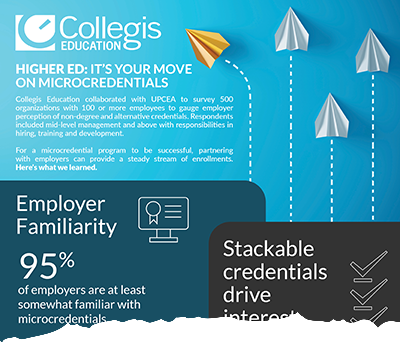Grant writers know that evidence is key to building a proposal. Searching for the right resource and sifting to find the right information can be a challenge. To make the higher ed grant writing process easier, we’ve compiled resources on hot topics to help you build a solid understanding of the higher ed landscape, easily access industry stats, and reference the latest research.
For adult learning, microcredential, and employer partnership grants
Our “Rethink Your Student Population” report dives into four distinct personas of adult learners and what motivates each one. One thousand adult learners interested in pursuing a degree were surveyed to create this report. Insights also include recruitment strategies and program optimization recommendations for each persona.
Want the highlights? Our infographic “The Adult Learners You’re Ignoring” covers the key takeaways from the larger report noted above.
Our 2024 report “Understanding Employer Perceptions of Higher Education Partnerships” is the second installment in the UPCEA-Collegis research series. Rich in firsthand data, the report covers the changing landscape of alternative credential programs, including the obstacles and opportunities perceived by employers when partnering with higher ed and the program features most important to securing a partnership.
Want the highlights? The corresponding “Securing Microcredential Partnerships” infographic provides a quick summary of the report with key findings.
In our 2023 report “The Effect of Employer Understanding and Engagement on Non-Degree Credentials,” co-written with UPCEA, we surveyed more than 500 employers about their perceptions of partnering with four-year higher ed institutions on professional development programs and alternative credentials. The report is full of statistics and includes info on what incentivizes employers to work with a school, and why those currently in a partnership plan to continue it.
Want the highlights? Our “Higher Ed: It’s Your Move on Microcredentials” infographic provides key takeaways from the report.
For technology and cybersecurity grants
Our “2024 Higher Ed Cybersecurity Landscape” ebook gives a thorough review of the higher ed landscape, with industry-specific data on the rise (and impacts) of cyberattacks and how schools can defend themselves. It also covers notable GLBA updates and AI impacts on security measures.
EDUCAUSE’s “2023 Students and Technology Report: Flexibility, Choice, and Equity in the Student Experience” presents data from its survey of 1,951 students across 10 higher ed institutions. This data-rich report has statistics and insights across three main themes: balancing engagements between residential and off-campus students; the role students play in the educational marketplace; and the role technology plays in the increasing expectations for schools to offer equitable education.
For enrollment, finances, academic staffing, and facilities grants
We’ve made IPEDS (Integrated Postsecondary Education Data System) data freely available to Google BigQuery users on the Google Analytics Hub. It uses familiar SQL queries and access tools within the Google Cloud platform, so you can explore institutional-level details on more than 7,000 colleges and universities across various categories, including enrollment growth, finances, academic staffing, and facilities. The data spans back to 2004-05, allowing you to analyze trends, demographics, and outcomes over 20 years.
Additional higher ed research
We hope you find these grant writing resources helpful and full of the information you need to build your proposal. Looking for more? We recommend checking out these sources:
- EDUCAUSE’s library on higher ed technology
- UPCEA’s online and professional education resources
- Gallup’s higher ed news, and Lumia Foundation research hub
- Georgetown University’s Center on Education and the Workforce
- Strada Education Foundation
- Council of Graduate Schools
Happy grant writing! If you’re looking for a thought partner to help you assess your institution’s opportunities for technology innovation and program strategy, we can help. Contact us to learn more.
Author: Collegis Education Staff
Collegis is passionate about education and driven by the technology that keeps institutions moving forward.







